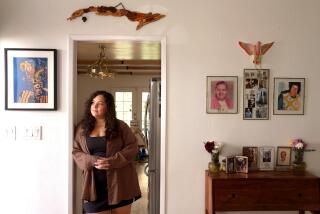Explaining Hollywood: How to get a job as a foley artist

- Share via
Back when silent movies gave way to talkies, filmmakers found that the microphones on their sets captured little more than the actors’ dialogue. Without additional sound recording, their films would show an eerily quiet world with stealthy figures heard only when they opened their mouths to speak.
The solution advanced by Jack Foley, a writer and director at Universal Studios, was to project the film on a screen and create a soundtrack of the noises he made as he mimicked the actors’ movements and actions. For example, he’d capture the patter of footsteps while walking in time with the actors, covering the floor with whatever material made the right noise. Similarly, he’d record the jingle of keys being drawn from a pocket, the smack of doors opening and closing, and the whoosh and crinkle of a chair cushion compressing under the weight of an actor sitting down.
His techniques were so influential, the entertainment industry named the practice after him. Today, foley artists work on foley stages and in foley studios, recorded by foley recordists and foley mixers and polished by foley editors.
These artists can now be found pretty much wherever movies, television shows or videogames are made. That’s true despite the vast improvement in microphone technology since the first time Foley mimicked an actor strolling down a sidewalk. And unlike the man himself, the names of modern foley artists show up in the credits — much of the time.
Who becomes a foley artist?
Live discussion
Talking foley on Clubhouse
Join foley artist Ellen Heuer, The Times’ Jon Healey and others on the Clubhouse app for a live discussion about the sounds you hear in films, TV shows and videogames.
When: 6 p.m. Pacific time, Tuesday, Aug. 24
Where: The L.A. Times’ club on Clubhouse
How: Download the Clubhouse app on your smartphone and join the L.A. Times club
Cost: Free
It’s worth noting up front that there aren’t a lot of them out there, although the field is much bigger than it was a few decades ago. A popular Facebook group about Foley lists nearly 6,000 members internationally, but the number of people actually making a living just as a foley artist is much smaller.
Vanessa Theme Ament, author of “The Foley Grail: The Art of Performing Sound for Film, Games, and Animation” and a veteran foley artist, guesses there are 40 to 50 established “top-notch” foley artists in the United States and at least 100 or 200 people who are dabbling or just getting started in the field.
“It’s a bit like professional tap dancers or professional harpists,” said Peter Burgis, an Emmy-winning U.K.-based foley artist with 330 film and videogame credits, according to IMDB.com. “Not that many of them.”
Although foley artists often are converted actors or musicians, the field has attracted people with a wide variety of backstories. Ament, who has spent years teaching the art at Ball State University in Indiana and other places, said her students have included people trained in architecture, engineering and the visual arts.
The various disciplines inform foley artists in different ways. Those who’ve been dancers say it helps them mimic the movements of characters on-screen. A background in music, Ament said, provides a sense of rhythm that comes in handy. And those who were actors say it helps them understand the emotions they need to convey through sound, a vital aspect of the work.
Beyond that, Ament said, “It helps if you’ve done something even being athletic, being naturally coordinated.” In fact, added Ellen Heuer, an Emmy-winning foley artist with credits on more than 300 features, TV shows and videogames, the work is “incredibly physical. It has an uncelebrated athleticism all its own.”
One other useful trait, Heuer said, is being “almost a little obsessive.” A good foley artist, she said, is one who is “worried about details that other people wouldn’t worry about.”
What does a TV writer do? How do you become one? How do you move up? How much money can you make? The L.A. Times is explaining the entertainment industry — here’s what you need to know about being a TV writer.
How do you get started?
This being the entertainment industry, professionals in the field say having connections to a working foley artist is crucial to getting started.
Ament said she was auditioning for a dialogue-dubbing gig when, helped by a foley artist acquaintance, she landed a spot doing foley at Gomillion Studios, a post-production house. “It was just going to be something I did between acting and singing,” Ament said. But she did well enough that she soon had steady work on TV shows and feature films, working both as a freelancer and in-house for post-production sound companies.
For the record:
7:02 p.m. Dec. 4, 2023This article incorrectly states that Katie Waters took a foley course at Columbia College Chicago taught by Vanessa Ament. The class was taught by Adrian Anguiano.
Katie Waters, a foley artist for the NoiseFloor sound house in Chicago, grew up with a love of acting, music and filmmaking, which culminated in her studying post-production sound work at Columbia College Chicago. Among her courses was one on the art and craft of foley taught by Ament.
Yet it took Waters years to find steady work. An internship at NoiseFloor helped her make connections there, and she did foley on a couple films there as a freelancer before she finally got hired at the company — as office manager, the only position that was open. She eventually moved up to become the company’s producer, doing foley when there was a demand for it. She’s now both NoiseFloor’s producer and in-house foley artist.
She advised people studying the craft to “meet as many filmmakers in school as possible, and do foley as much as you can. And stay connected with those people. ... The more you do it, the more people will find out that you do it, and then you’ll get more work.”
There are a number of film and trade schools offering classes in foley as part of a broader movie- or sound-related program. It’s hardly a prerequisite for working as a foley artist or a guarantee of a career in the field. But Andreina Gomez Casanova, a Venezuelan foley artist and sound editor who trained at the University of Hertfordshire in England, said “a degree will give you the opportunity to connect with other people. And to perfect your technical skills. But the most important thing is to connect with people.”
Burgis had gone from a television hosting gig at the BBC to a job as an assistant at a sound studio when he got the chance to perform footsteps with an established foley artist, who told him he was a natural. That was around 1991, he said, and with the country mired in a deep recession, he had to make a choice: “I could carry on being a mediocre assistant or I could be an unemployed foley artist. So I became an unemployed foley artist.”
He spent about five years doing foley for commercials and other small-budget projects before he landed his first feature film. It takes a long time, Burgis said, to develop the “good sound library in your head,” the knowledge required to recognize the sound demanded by a scene. He spent days listening to people at the seafront and in the subway — not what they said, but the sounds they made as they moved and how that was affected by the things they carried.
How do you build and sustain a career as a special-effects artist in the rapidly evolving entertainment industry? We asked experts for their advice.
What are the career paths?
There are a slew of jobs associated with the foley process, which is itself just a portion of the work done on the sound of a film, TV series or game. But as Heuer noted, the skills needed to be, say, a foley mixer or editor are very different from those required of a foley artist.
“One involves a machine,” she said, referring to the computers used for digital recording and editing, “and the other is just a performance.”
In other words, doing well as a foley artist doesn’t naturally lead you to becoming a sound designer or sound editor. But it does help you make the connections needed to attract more work and, potentially, launch your own foley studio.
How do you make money? (And what kind of money?)
Foley artists either work on a freelance basis or as an employee of a studio (Ament noted that some of the large Hollywood studios have in-house foley artists), a post-production sound company or, increasingly, videogame developers. The pay scale in the U.S. is shaped by the Motion Picture Editors Guild, whose contracts call for hourly wages of $47 to $95 and for weekly wages of $1,884 to $3,032, depending on the size and location of the production.
Those wages apply only to jobs done with union labor, and it’s worth remembering that for people new to the field, the work can be intermittent. The advent of streaming video has increased the volume of programs produced, but it’s also shortened seasons and tightened production budgets.
Meanwhile, the demand for foley in Los Angeles from feature films has waned, Heuer said. “It’s all TV; it’s all Netflix,” she said. “Their budgets aren’t the same, so the money’s not the same. It’s still decent, but it’s sure not what it used to be.”
Gomez, who’s been a foley artist for four years, said the gaps between jobs can make it hard to earn a living. She sometimes waits two to three months for the next assignment. “I would encourage people to find other things they are passionate about” to do in addition to foley gigs, she said, adding, “In sound editing, you will always find work.”
Film producers will tell you that there’s no typical day in the job -- and there’s no single path to becoming a producer. But there are traits you can develop and entertainment industry paths to follow that will set you up for a career in Hollywood.
How is this career different than it was 10 or 25 years ago?
Just as the number of foley artists has grown, so have the opportunities. Videogames are increasingly cinematic, and like other animation-based videos, they rely on manufactured sound.
Granted, doing foley to create realistic sound for animated people can be a challenge. “Sometimes, really rough renditions of animation are incredibly difficult, because they are not human, they do not move in ways you can predict,” Heuer said.
Nonhumans are a whole other issue. On “Who Framed Roger Rabbit,” Heuer said, her team spent hours trying to work out how to make the title character’s body sound funny. They found that a fuzzy bunny wasn’t a funny bunny, but a rubber one was. So “when his ears twisted [on-screen], we used rubber,” she said, adding, “You have to develop the part of your brain that uses your imagination in such a way that you’re entertaining people with sound.”
One other big change over the last 20 years has been the shift from analog to digital audio. Waters said there are foley sound effect libraries available now that include recordings of such things as people walking (with variations for different types of shoes), keys jingling and clothes rustling. “People have tried to develop these, and you can buy them and use them if you don’t have access to a foley artist,” Waters said.
But pasting in snippets of sound synchronized to the video is not just inefficient and less cost-effective; it lacks the all-important performance aspect of foley. Heuer recalled the time she was doing the footsteps for Meryl Streep’s ailing character in the film “Ironweed,” and one of the sound editors, Kay Rose, had her do it again and again, saying: “I can’t hear the pain, Ellen.”
What do you often hear that’s wrong?
To Burgis, the biggest myth is that “foley is a job where you make noise.” That’s the least important part of the job, he said, because anyone can do it. Rather, Burgis said, making noise is “one of the things that you do as a result of all the other things you put into being artist,” he said. “Foley is about being an artist.”
Ament said a lot of her students have come in with the presupposition that “there was an absolutely right way to do things.” But that’s not true. There are some conventions in the industry, Ament said, but many different approaches to creating the sound that matches what’s on-screen.
Nor is a foley artist someone who spends hours on location, capturing the real-life sounds made by people and objects so they can be plugged into a film’s soundtrack, Waters said. That’s a different part of the sound-effects world.
Granted, Waters said, realism is important, because foley artists don’t want their work to draw the viewer’s attention away from the story. The goal is to help convince people that what they’re seeing on the screen is real. As Heuer put it, “a good foley job shouldn’t be noticed.” Yet foley artists also have to support the emotions on the screen. And sometimes, Heuer said, “the real thing doesn’t sound as good as the foley thing.”
For her part, Gomez said, “I hate the phrase, ‘Work hard and you’ll achieve your dreams.’ ... You also need to connect people to the right people, like serious people and kind people. That’s so important. I know that’s a soft skill. Connecting with kind people will really give you great jobs. Kind people who are aligned with your mind-set.”
What’s some good advice?
- Although there is no single best route into the field, having a background in music, dance or theater can be an important asset. “I would really encourage people to take acting lessons,” Gomez added. She did, and “it really helped me to understand what the character is feeling, their place in space.”
- Find a way into that private foley artists group on Facebook, whose members include some of the top people working in the field. “That group is amazing, and I think that group will really help people,” Gomez said.
- “Practice, practice, practice, practice, practice. It doesn’t matter where,” Burgis said, adding, “practice walking in time with people.” Gomez suggested, “Just take one video and mute it and record your own foley. Don’t wait to have a project to practice.”
- “You really need a good understanding of the whole filmmaking process in order to find your place in it,” said Burgis. For one thing, he said, it’s important to recognize the points in a film when it’s better off without your contribution.
- You need to be willing to accept it when an editor tells you that the sounds you’ve produced don’t work in a particular scene. “Your job is to provide, rather than to decide,” Burgis said. “The humility comes when people say, ‘No, I don’t like that. Let’s do something else.’ You can’t have an ego.”
When asked what she would tell aspiring foley artists, Heuer was blunt: “Don’t.” But then she walked that sentiment back, at least a little. “If that’s what [you] want to do, then do it,” Heuer advised. “But be prepared for something else to come along that might be your real calling. That’s what happened to me.”
In her case, her real calling wasn’t being a dancer or an actor. It was being a foley artist.
The entertainment industry has been plagued by scams targeting acting hopefuls, parents of child actors and others. Here’s what to look out for and what to do.
More to Read
Inside the business of entertainment
The Wide Shot brings you news, analysis and insights on everything from streaming wars to production — and what it all means for the future.
You may occasionally receive promotional content from the Los Angeles Times.















